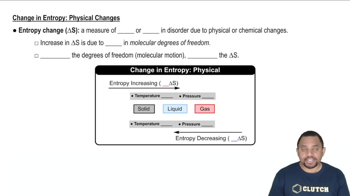Here are the essential concepts you must grasp in order to answer the question correctly.
Entropy
Entropy is a measure of the disorder or randomness in a system. It quantifies the number of possible microstates that correspond to a given macrostate. Higher entropy indicates greater disorder and more available microstates, which typically occurs at higher temperatures or in less constrained environments.
Recommended video:
Entropy in Thermodynamics
Effect of Temperature on Entropy
Temperature has a direct impact on the entropy of a substance. As temperature increases, the kinetic energy of the molecules also increases, leading to greater molecular motion and, consequently, higher entropy. This means that a gas at a higher temperature will generally have higher entropy than the same gas at a lower temperature.
Recommended video:
Entropy and Physical Changes
Effect of Pressure on Entropy
Pressure influences the entropy of gases significantly. At lower pressures, gas molecules have more space to move around, resulting in higher entropy. Conversely, at higher pressures, the molecules are more confined, leading to lower entropy. Therefore, comparing states at different pressures is crucial for determining their relative entropies.
Recommended video:
Entropy and Physical Changes



